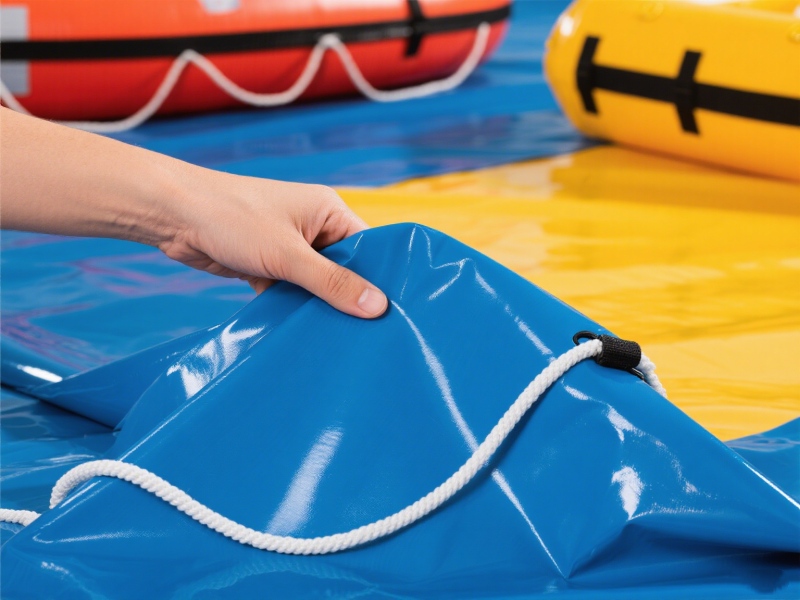It’s easy to overlook the fabric when thinking about life rafts. After all, they’re just supposed to float and stay strong—right? But behind every reliable inflatable raft is a carefully engineered fabric, and if you're reading this, you're likely someone who understands that not all PVC fabrics are created equal. Whether you're a safety equipment buyer, a marine engineer, or a raft manufacturer, the quality of the PVC life raft fabric can mean the difference between dependability and disaster. Let’s take a closer look at why it matters so much.
PVC Life Raft Fabric: More Than Just a Shell

PVC (Polyvinyl Chloride) fabric used in life rafts is not simply plastic-coated cloth. It’s a multilayer composite material, typically consisting of a woven polyester or nylon base, coated with flexible PVC. This design balances mechanical strength with airtightness, two critical properties for inflatable life-saving devices.
High-quality PVC life raft fabrics are formulated with:
1. Strong adhesion between layers to prevent delamination.
2. UV stabilizers to resist degradation from sunlight.
3. Plasticizers engineered for flexibility without compromising strength.
4. Anti-wicking treatments to prevent water ingress through stitching points.
The Stakes Are High: Safety First
In marine emergencies, life rafts often face saltwater, sun exposure, rough weather, and long periods of deployment. If the fabric fails, the entire raft fails. That’s why high-quality PVC fabric must pass rigorous performance tests, including:
Tensile strength & tear resistance: To withstand pressure when fully inflated.
Puncture resistance: Against sharp objects or debris in open waters.
Air retention: No slow leaks, even under prolonged stress.
Low-temperature flexibility: Essential in cold climates or polar expeditions.
Flame retardancy: To comply with SOLAS and other marine safety standards.
Lower-grade fabrics may work for temporary use but can become brittle, crack under UV exposure, or develop micro-leaks over time—none of which are acceptable for life-saving equipment.
PVC vs Other Materials: Why it’s Still a Top Choice
While Hypalon (CSM) and TPU-coated fabrics also appear in the market, PVC remains a top choice for many manufacturers due to its balance of performance, cost-effectiveness, and processability. Here's why:
| Property | PVC Fabric | Hypalon | TPU-Coated Fabric |
| Cost | Low-Mid | High | High |
| UV Resistance | Good (with additives) | Excellent | Very Good |
| Flexibility | Flexibility | Good | Excellent |
| Weldability | Easy (hot air, RF) | Difficult | Moderate |
| Air Retention | Very Good | Good | Excellent |
| Abrasion Resistance | Moderate-High | High | Very High |
When properly engineered, high-grade PVC fabric can match or even exceed the performance of costlier alternatives in controlled marine environments.
Certifications Matter: It’s Not Just Marketing
Look for PVC fabrics that comply with international marine safety regulations such as:
▪ SOLAS (Safety of Life at Sea)
▪ ISO 9650 and ISO 15738
▪ IMO A.689(17) Guidelines
These standards cover everything from buoyancy to temperature resistance, and only high-quality PVC fabrics can reliably meet these requirements without premature failure or performance degradation.
If you're working with international tenders, shipping companies, or government supply contracts, these certifications are non-negotiable—and your choice of fabric must align with them.
What Does “High Quality” Actually Look Like?
It’s not just about specs on a datasheet. When evaluating PVC life raft fabric quality, consider:
1. Uniform surface finish with no bubbles or wrinkles
2. Strong and consistent weld seam behavior
3. No odor of cheap plasticizers (usually indicates poor chemical stability)
4. Trusted brand or supplier history, ideally with marine industry references
5. Batch traceability and in-house test data availability
A reputable supplier will be open about their formulation, base fabric type, testing methods, and even offer customized grades for specific environments.
At the heart of every reliable life raft is the PVC fabric it’s made from. Choose poorly, and you compromise everything that raft is meant to do. Choose wisely, and you build a product that stands up to nature—and saves lives when it matters most.
So next time you’re comparing specs, don’t stop at the raft structure or inflation valves. Take a long, close look at the fabric. It’s not just a layer—it’s the lifeline.






























